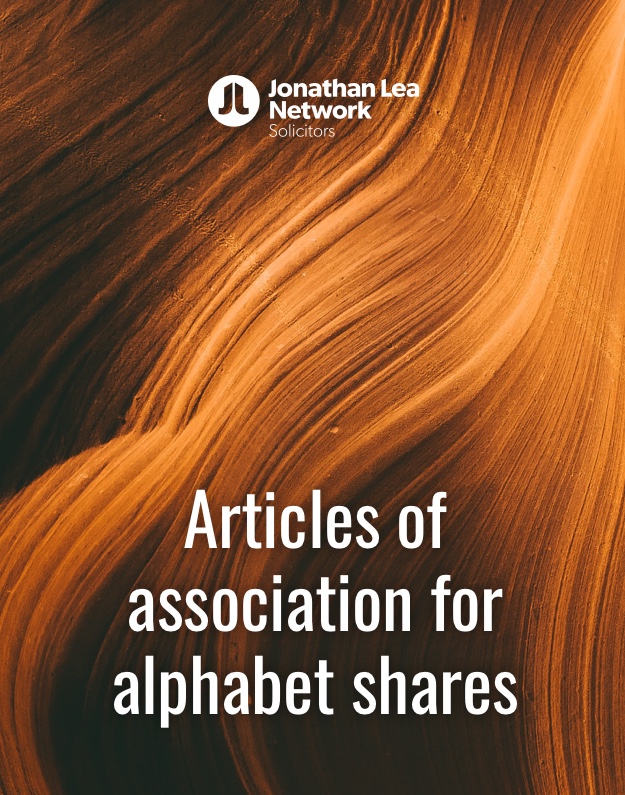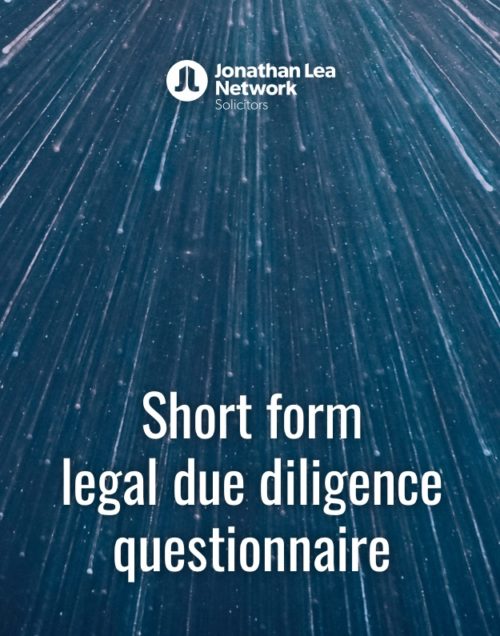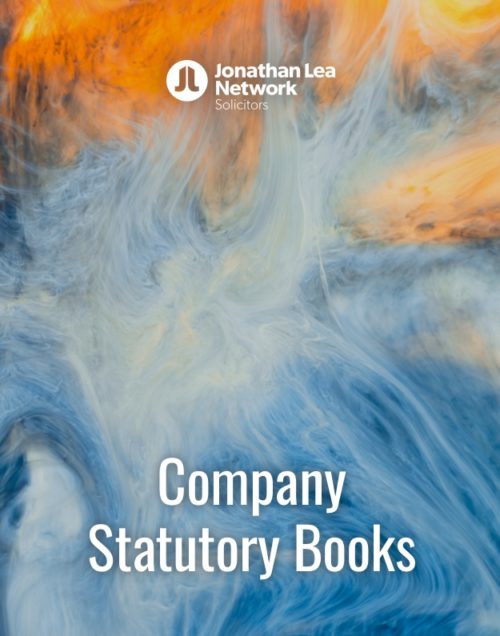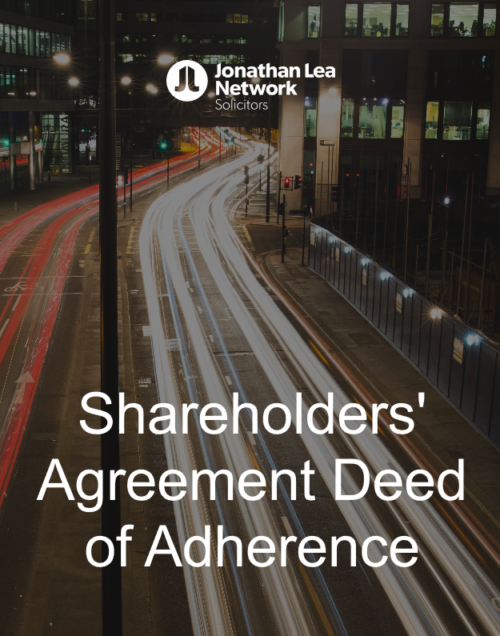Articles of association for alphabet shares
£31.99
This product constitutes an easily adaptable set of new articles for inclusion alongside a private limited, UK registered company’s existing articles of association so as to implement an alphabet share arrangement. These new articles will dovetail the company’s existing articles and will make clear that the existing articles will continue to apply, save insofar as they are varied or excluded by, or are inconsistent with, the new articles.
Alphabet shares allow the business to effectively assign their shareholders with shares in different classes, and these separate share classes are usually identifiable by a specific letter (hence the term ‘alphabet shares’) – for example a company could have categories of shares such as ‘A ordinary’ and ‘B ordinary’ shares.
The use of alphabet shares could help a business pay its shareholders different amounts of dividends depending on what class of share they own, or assign different rights to the holders of each class of share (for example, with regards to voting at meetings and on shareholder resolutions or with regards to capital distributions on the winding up of the company).
Further down the page are our guidance notes relating to this template which you will also receive as a separate document when you buy the product
Guidance notes to new articles of association (alphabet shares)
This guide aims to explain what alphabet shares are and sets out how to correctly amend the template articles so as to properly implement an alphabet share scheme.
What are alphabet shares?
Alphabet shares provide businesses with an alternative way of raising equity finance as they expand and more shareholders join the company. A company that is limited by shares will have been set up with a nominal number of ordinary shares in issue, (e.g., £1.00 per share).
Alphabet shares enable the business to effectively assign shareholders with different classes of shares, and these separate share classes are identifiable by a specific letter (hence the term ‘Alphabet Shares’). For example, the company may choose to have different categories of shares such as “A” Ordinary shares, “B” Ordinary shares, “C” Ordinary shares and so on.
The use of alphabet shares could help a business to pay shareholders different amounts of dividends depending on what class of share they own. Alternatively, alphabet shares are used in companies owned by families or in joint ventures so as to give certain shareholders the power to make important decisions (for example to appoint a director).
It is important to be aware that if your company’s articles of association do not identify what rights are attached to each different class of share then they will rank pari passu with one another – meaning they all rank equally. This could lead to shareholders becoming unhappy as a situation could materialise where one shareholder who owns a class of shares that represent a minimal amount of money could be entitled to the same dividend rights as another shareholder who owns a class of shares that represent a significant amount of money.
To avoid this, ensure that your company’s articles of association are amended via a special resolution (at least 75% approval of the shareholders) so that the rights attaching to each different class of share is added. Once this has been done, one rate of dividend can be paid to the shareholder(s) owning, for example, “A” Ordinary Shares and a different rate can be paid to the shareholder(s) owning “B” Ordinary Shares and so on.
Such an amendment to your company’s articles is essential in order to circumvent the ‘model article’ and ‘Table A’ provisions that demand dividends be paid in proportion to the number of shares held. As mentioned above, unless otherwise stated in the articles of association, in relation to all other rights such as voting and rights to capital on a winding up, the different classes of shares will usually rank equally.
Typically, the process of implementing an alphabet share scheme involves the following:
- The company creating a new class of shares (or classes of shares);
- Detailing the rights attaching to the new share classes in a set of new articles of association;
- Ensuring that these new articles detailing new share class rights are adopted by special resolution (this can be a written resolution);
- The company deciding (once the new share classes have been created) to either allot new shares of the classes concerned or have existing shares converted to the new classes (which route is decided upon will impact what statement of capital forms need to be completed and filed at Companies House);
- Both directors and shareholders considering and approving the changes to the company’s existing articles; and
- Sending notices of the relevant statutory forms and shareholder resolutions (along with a dated copy of the new articles) to Companies House within the prescribed time limits.
Template breakdown
Your input is required at the parts of the template highlighted in yellow. The wording inside the square brackets explains clearly the information that should be inserted. You are advised to fill in the wording in square brackets in lower case unless directed otherwise. Any figures should be entered in numerical form. The brackets should be removed after the amendments are made (so as to produce a ‘final form’ set of new articles).
These articles are intended as a template only and must be adapted to your particular circumstances.
Article 1 (Introduction)
Article 1.1 confirms that the company’s existing articles of association it was incorporated with shall continue to apply, save insofar as they are varied or excluded by, or are inconsistent with, the new articles. If the company has amended its articles of association since incorporation, amend this article accordingly and insert the date that the company’s most recent/up-to-date articles of association were filed at Companies House.
Article 2 (Defined terms)
We have drafted the template articles on the basis that the company will be creating three new share classes (being A Ordinary, B Ordinary and C Ordinary classes). You can amend this depending on your purposes and can have more or less share classes as you desire.
For each new share class, you should insert the nominal value in the square brackets provided.
Article 2 sets out the definitions that will apply throughout the new articles – the main purpose behind this is to reduce repetition within the body of the articles, making them shorter and easier to read. Unless expressly defined, the courts will interpret non-technical terms in accordance with their ordinary and natural meaning, or the meaning which can be inferred by the words that the parties chose to use in the articles.
Article 3 (Rights attaching to shares)
Our template articles have been drafted on the basis that the main intention behind the implementation of the alphabet share scheme is so that the company (via its directors) can pay the holders of the different classes of shares different rates of dividends above their pro rata entitlements. The reasoning for this is because this is the most common motive our clients have behind wanting to implement such schemes.
As regarding voting
If you choose the first optional provision, the different share classes rank equally as regarding voting.
The second optional provision contains an example of an alternative way the articles could be drafted as regarding voting. It provides that the A Ordinary and B Ordinary shares carry voting rights, however the C Ordinary shares do not carry any voting rights (only the right to attend and receive notice of general meetings). You can of course tweak this optional provision to fit your circumstances.
As regarding dividends
If you wish for the shareholders to receive equal dividends when the company’s directors determine that there are sufficient distributable profits available so as to justify declaring a dividend, you should use the wording contained within the first optional provision under this section. This will result in the share classes having equal rights as regarding dividends.
If you wish for the company’s board to be able to declare different (i.e. unequal) amounts of dividends in respect of each share class, you should choose the second optional provision. This will result in the share classes being treated as different for the purpose of distribution of company profits by way of dividend.
Please note that while the Companies Act 2006 does not specify who shall declare dividends and, in particular, there is no requirement for any dividends (whether final or interim) to be declared by shareholders, under the model articles for private companies limited by shares, model article 30(1) provides that “The company may by ordinary resolution declare dividends, and the directors may decide to pay interim dividends”. Standard practice in these circumstances means that, whereas directors can resolve to pay interim dividends, final dividends should be recommended by directors but declared by shareholders by ordinary resolution.
As regards to capital (including on a winding up)
The first optional provision under this section of the articles confirms that the A Ordinary, B Ordinary and C Ordinary shares shall be treated the same for the purpose of distribution of capital (including on a winding up of the company), with distributions under such circumstances being made on a pro rata basis. You should opt for this provision if you would like the share classes to rank equally in terms of distributions of capital (and for the shareholders of the different classes of shares to each receive their pro rata entitlement).
Alternatively, you could choose the second optional provision which provides that the A Ordinary Shares have a preferential right to capital (including on a winding up of the company), with the B Ordinary Shares ranking second (above the C Ordinary Shares) and the C Ordinary Shares ranking last in terms of capital distributions. This provision can be easily tweaked to fit the particular scenario depending on what level of priority you wish to give to the different share classes.
Other rights
You may also consider adding the following or other types of rights:
- Restricting the transfer of other classes of shares or further shares in a particular class from being allotted by the company (so as to protect the shareholders in each class from dilution);
- Specifying that holders of certain classes of shares do not have the ability to appoint/remove directors.
- Note that under the model articles of association for private companies limited by shares, model article 17(1) provides that a director can be appointed by way of ordinary resolution (i.e. a resolution passed by a simple majority of the shareholders of a company – meaning more than 50% of votes cast are in favour of it) or by a decision of the directors. A company may wish to control which shareholders can appoint and remove directors and so could insert provisions into the new articles to make this clear. Note further that the directors of a private limited company can also be removed as a director by an ordinary resolution in accordance with section 168 of the Companies Act 2006.









